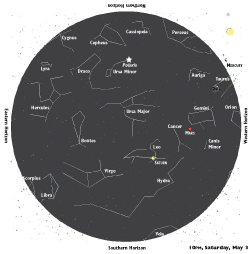Mercury Rising
Take a look at this little-studied planet
As the planet nearest the sun, Mercury never strays far, its blinding glare making it the most difficult naked-eye planet to spot. But you have one of the best opportunities of the year to see this elusive planet in its full glory.
Mercury will be visible throughout almost all of May, but it shines its brightest early in this apparition Thursday, May 1. As the sun sets a few minutes past 8pm this week, look above the western horizon for a piercing light equal to the brightest stars.
At week’s end, Mercury shines near the horns of Taurus the bull and is just a couple degrees below the dim stars of the Pleiades cluster. Of the seven crying sisters, only six remain visible, and even so, you may need binoculars or a telescope to discern it amid twilight’s glare.
Tuesday, Mercury joins the ever-so-thin moon, itself just reemerging from the sun’s glare. Look for the planet’s bright, steady light just a few degrees below the crescent moon’s lower leg.
Over the next couple weeks, even as Mercury dims it climbs higher and later into the evening sky, peaking around mid-month, then settling back toward the horizon and the sun.
It might surprise you to know that Mercury is half the distance from us as Mars, yet it is the least-studied planet. Again, Mercury’s proximity to the sun limits Earth-based observation, and the only spacecraft that ever visited the planet was back in 1974 when Mariner 10 flew past three times, mapping about half the planet’s surface before succumbing to the heat from the sun. NASA launched a second probe, MESSENGER, in 2004, but it won’t reach Mercury until 2011.
Tidelog®
Illustration: © Copyright 1925 M.C. Escher/Cordon Art-Baarn-Holland; Graphics: © Copyright 2007 Pacific Publishers. Reprinted by permission from the Tidelog graphic almanac. Bound copies of the annual Tidelog for Chesapeake Bay are $14.95 ppd. from Pacific Publishers, Box 480, Bolinas, CA 94924. Phone 415-868-2909. Weather affects tides. This information is believed to be reliable but no guarantee of accuracy is made by Bay Weekly or Pacific Publishers. The actual layout of Tidelog differs from that used in Bay Weekly. Tidelog graphics are repositioned to reflect Bay Weekly’s distribution cycle.Tides are based on National Oceanic and Atmospheric Administration and are positioned to coincide with high and low tides of Tidelog.
